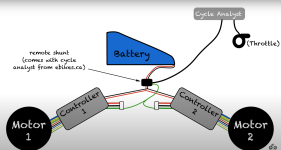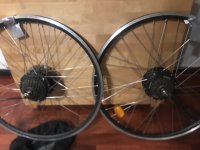I ran 2 WD's for almost a decade.When I started w/ it I was queer for mini motors, specificly the then wildly popular Q100's and I wanted to see how fast I could go using 2 of them. Generaly, when one runs a single high-speed range mini you might 25 mph, but with a very lazy mid-range. Worse than that, the "328" is so tall it never really gets into an efficient rpm range, the motor tries to get all the Amps it can and phase wires and connectors start melting. Using two, they tended to pull each other along a top speed and I could get 27 or 28 mph. Although the bike still slowed a bit in the mid range, it wasn't too bad. I could still melt wires, especially off-road where even with 2WD, the rear does the bulk of the work. What happens is the rear system, if it makes any power at all, lifts the frt. and that tire spins. Happens on the street too.
These days, I use better motors and if I deemed that my current single Bafang felt underpowered, I would go up a step to a mid running 35 to 40 Amps. More than that and traction becomes a problem and then maybe a 2WD would be useful.
The dual mini powered was good on wet grass and I suspose it would be good in snow.
After trying different combo.s of controllers, batteries, throttle and motors, I ended up with two of everything. I use LiPoly bricks which are modular, so no downside to 2 batt.s. Controllers are small and Cutes were light and cheap.
What made it work well was both throttles on the left side, a left-hand half-twist shoved up next the a left-hand thumb, very intutitive and easy to modulate. I would think, that even with todays better electronics trying to aportion the power in low-traction situations, the human brain can still do a better job.
Two minis weren't too bad in terms of weight, but two midi's were just too heavy for me to want to carry the bike up the stairs.
Although I never made use of having redundent systems in an emergency to get home, there is a sense of security that comes with having a back-up.
Most of the time, I just used the rear throttle and added frt. power as needed. As a result, the frt. batt. used about 1/3 rd of power reserve compared to the rear. The frt.. batt. was about half the size of the rear.
I did PAS on the rear and throttle for the frt. for a while and that worked fairly well. Just the controllers I was using back then didn't do PAS very well.



